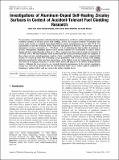Investigations of Aluminum-Doped Self-Healing Zircaloy Surfaces in Context of Accident-Tolerant Fuel Cladding Research
Author(s)
Carr, James; Vasudevamurthy, Gokul; Hinderliter, Brian; Massey, Caleb; Snead, Lance
Download11665_2016_Article_2094.pdf (4.144Mb)
PUBLISHER_POLICY
Publisher Policy
Article is made available in accordance with the publisher's policy and may be subject to US copyright law. Please refer to the publisher's site for terms of use.
Terms of use
Metadata
Show full item recordAbstract
We present here some important results investigating aluminum as an effective surface dopant for increased oxidation resistance of zircaloy nuclear fuel cladding. At first, the transport behavior of aluminum into reactor grade zircaloy was studied using simple diffusion couples at temperatures greater than 770 K. The experiments revealed the formation of tens of microns thick graded Zr-Al layers. The activation energy of aluminum in zircaloy was found to be ~175 kJ/mol (~1.8 eV), indicating the high mobility of aluminum in zircaloy. Subsequently, aluminum sputter-coated zircaloy coupons were heat-treated to achieve surface doping and form compositionally graded layers. These coupons were then tested in steam environments at 1073 and 1273 K. The microstructure of the as-fabricated and steam-corroded specimens was compared to those of pure zircaloy control specimens. Analysis of data revealed that aluminum effectively competed with zircaloy for oxygen up until 1073 K blocking oxygen penetration, with no traces of large scale spalling, indicating mechanically stable interfaces and surfaces. At the highest steam test temperatures, aluminum was observed to segregate from the Zr-Al alloy under layers and migrate to the surface forming discrete clusters. Although this is perceived as an extremely desirable phenomenon, in the current experiments, oxygen was observed to penetrate into the zirconium-rich under layers, which could be attributed to formation of surface defects such as cracks in the surface alumina layers.
Date issued
2016-05Department
MIT Nuclear Reactor LaboratoryJournal
Journal of Materials Engineering and Performance
Publisher
Springer US
Citation
Carr, James, Gokul Vasudevamurthy, Lance Snead, Brian Hinderliter, and Caleb Massey. “Investigations of Aluminum-Doped Self-Healing Zircaloy Surfaces in Context of Accident-Tolerant Fuel Cladding Research.” Journal of Materials Engineering and Performance 25, no. 6 (May 5, 2016): 2347–2355.
Version: Author's final manuscript
ISSN
1059-9495
1544-1024